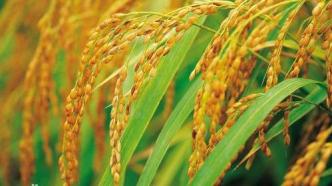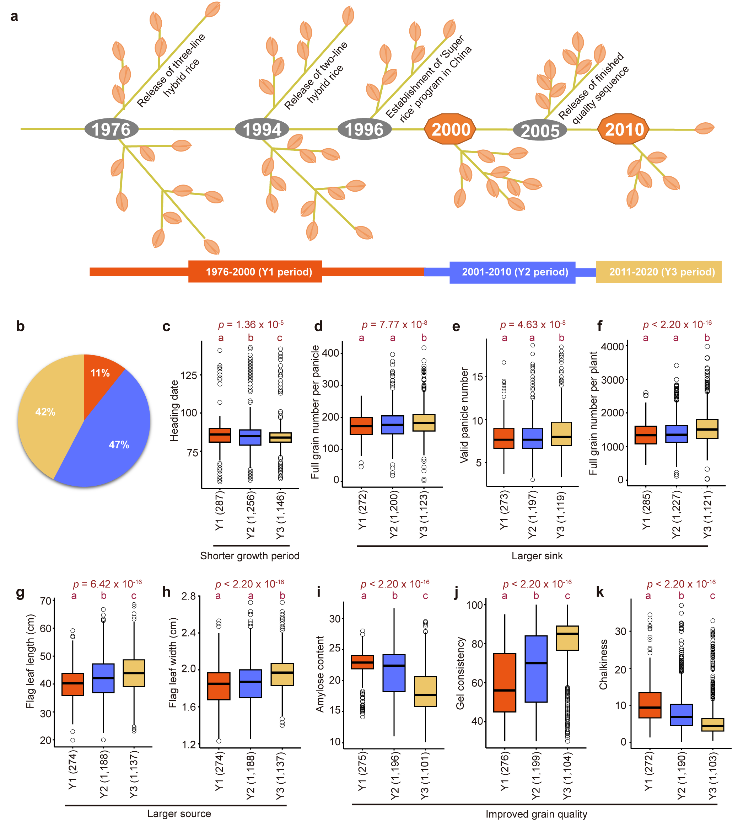
On the morning of September 8, The Paper learned from the Chinese Academy of Sciences Molecular Plant Science Excellence Innovation Center that on the 7th, the team of academician Han Bin of the center published an online publication entitled "Hybrid Rice Hybrid Rice" in the international academic journal Nature Genetics. Structure and function of rice hybrid genomes reveal genetic basis and optimal performance of heterosis" research paper.
Based on the excellent materials of hybrid breeding, the research refined and summarized the theoretical basis, and then used the theory to feed back practice, providing theoretical guidance and valuable resources for promoting the innovation of hybrid rice breeding technology.
This study evaluated the achievements of cross breeding in the past half century from the time dimension, identified the molecular imprint of improved breeding, quantified the dominance and phenotypic contribution rate of key loci in improved breeding, summarized the genetic rules of breeding, and deeply analyzed the differences between subspecies. The genetic basis of hybrid vigor, and a genomic selection model was constructed to quickly screen excellent hybrid combinations and shorten the hybrid breeding cycle.

Division of three breeding stages and analysis of phenotypic change trends of materials at different breeding stages.
Reviewing half a century of achievements in hybrid rice breeding
In the early 1970s, Mr. Yuan Longping and his assistants discovered a naturally sterile individual in the wild rice population, which promoted the commercial development of hybrid rice breeding. Hybrid rice breeding has greatly increased the yield of rice, achieving the second jump in yield after semi-dwarf breeding, and is known as the "second green revolution."
In the past half century, a large number of hybrid rice varieties have been bred. If the genome and phenotype information of a large number of excellent hybrid rice varieties can be analyzed, it can help to analyze the genetic basis of heterosis formation and analyze the changes in the genome structure of hybrid rice varieties from the time dimension. , and can help explore the laws of hybrid vigor in improved breeding.
The team of Han Bin, a researcher at the Center for Excellence in Molecular Plant Science of the Chinese Academy of Sciences and an academician of the Chinese Academy of Sciences, together with Yang Shihua, a researcher at the China Rice Research Institute, and Gong Junyi, an associate researcher, collected 2,839 hybrid rice germplasm resources. These resources cover the entire history of hybrid rice breeding in China and are the largest collection of hybrid rice germplasm resources reported so far. Among them, 18 representative hybrid rice materials were selected to construct an F2 population containing 10,000 individuals.
Based on the genotype and phenotype data of more than 10,000 materials mentioned above, this study constructed a genomic selection model. The model can predict the field performance of materials based on the genomic genetic variation information of the hybrid combination, and combine the prediction results of seven important agronomic traits to carry out multi-trait selection, so as to realize the efficient screening of breeding potential individuals, help breeders to formulate hybridization plans, and shorten the breeding time. cycle, saving manpower and time costs.
In addition, since the training set contains a large number of F2 individuals from inter-subspecies hybrid rice, the model can effectively process the genotype data of inter-subspecies hybrid rice, so it is suitable for the selection of inter-subspecies hybrid combinations and is expected to promote inter-subspecies hybridization. Development of rice breeding .
This study reviewed the achievements of improved breeding by analyzing the phenotypic change trends of 2839 hybrid rice varieties: 1. The pool organs were significantly increased, including the number of grains per panicle and the number of effective panicles. The enlargement of the reservoir organ builds a high-yield shelf for materials and lays the foundation for increased output. 2. In order to match the enlarged sink organs, the source organs were significantly enlarged, including the leaf length and leaf width of the flag leaf, the main photosynthetic organ, to improve the grouting ability of the source organs; 3. The heading period was slightly shortened. Climatic conditions in the late growth period of rice (grain-filling period) are variable, and extreme weather may affect rice yields and even lead to grain failure. A slightly shortened heading period can reduce the risk of materials encountering extreme weather in the late growth period, thereby improving the stable yield performance of materials; 4. The cooking quality and appearance quality of grains are significantly improved. The rice quality of early hybrid rice was poor. Through the unremitting improvements of breeders, the quality of rice has been significantly improved.
The shortening of heading period and the improvement of rice quality have brought great challenges to increasing or maintaining current yield levels. This study found that hybrid rice breeding achieved a slight increase in yield per plant through source-sink collaborative improvement.
How to avoid "holding back" genotypes: genome introgression, or parental collaborative improvement
The study found that during the process of hybrid rice improvement and breeding, the gradual increase in the genomic genetic diversity of the hybrid rice population was related to the gradual increase in the number of TJ (Twoline-Jap) type hybrid rice. According to previous reports by Han Bin’s team, this type of hybrid rice belongs to the two-line hybrid seed production system, mostly of indica-indica hybrid rice type, but contains japonica-type organelles, and lineage tracing shows that the ancestor material of this type of hybrid rice is japonica type (Nongken 58S) (Gu et al., 2021).
A newly published study found that compared with WA (wild abortion type, wild abortion type, three-line hybrid breeding) hybrid rice, the nuclear genome of TJ hybrid rice contains a higher level of japonica rice infiltration , and the superior alleles of japonica rice origin Mutations are used more frequently.
Therefore, the researchers believe that the development of new germplasm resources and seed production systems will help to introduce and widely use superior allelic variation through genome introgression .
In addition, this study used genome-wide association analysis to locate the main loci that regulate the yield and quality of hybrid rice. The study pointed out that breeding improves traits by selecting appropriate genotypes through the genetic effects of loci. Taking rice quality as an example, most of the main effect loci show negative dominant effects, which is consistent with the inherent impression that quality is difficult to show heterosis, and it also means that heterozygous genotypes will "hold back" . Therefore, improved breeding uses synergistic improvement of both parents to equip both parents with dominant allelic genotypes at the target loci at the same time, so that F1 (offspring generation) can obtain dominant homozygous genotypes. This also provides some inspiration for hybrid rice breeding: for dominant (partially dominant) effect loci, you can choose to improve only one parent, and for superdominant loci, the parents must have different genotypes, while additive effects or negative dominant loci Sexual effect loci must achieve synergistic improvement of both parents to maximize the hybrid vigor effect.

Most of the major rice quality-related genes showed negative dominant effects and the dominant allele frequencies of the four major loci increased synergistically in both parents.
Han Bin and Yang Shihua are the co-corresponding authors of the aforementioned paper. Gu Zhoulin, a postdoctoral fellow at the Center for Excellence in Molecular Plant Science, Chinese Academy of Sciences, Gong Junyi, an associate researcher at the China Rice Research Institute, and Zhu Zhou and Li Zhen, PhD candidates at the Center for Excellence in Molecular Plant Science, Chinese Academy of Sciences, are the co-first authors of the paper. Professor Huang Xuehui from Shanghai Normal University, Professor Yang Jian from West Lake University and Professor Dale Sanders from the John Innes Center provided constructive comments and important guidance for the study. The research was funded by the National Natural Science Foundation of China, the Pilot Project of the Chinese Academy of Sciences (Type B), the Shanghai Municipal Science and Technology Commission, and the China Postdoctoral Science Foundation.
Paper link: https://www.nature.com/articles/s41588-023-01495-8